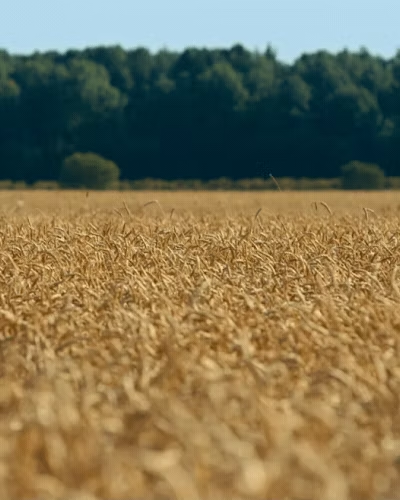Navigating the future: how an Arctic seed vault will save the world
Agriculture is arguably the greatest driver of human development the world has ever seen. It employs a quarter of the global workforce and has been a catalyst for major technological advancements throughout history. But it can also be highly destructive. Today, many of our environmental catastrophes, including deforestation, loss of biodiversity and carbon emissions, can be linked to agriculture. With food production placing a significant strain on our global ecosystems, the race is on to solve one of the 21st century's most consequential questions: can the world feed itself sustainably?

Somewhere on a frozen archipelago deep inside the Arctic Circle sits a bunker surrounded by glaciers and polar bears. The only visible sign of human activity is an imposing slab of concrete that pushes out from the Arctic tundra. It looks otherworldly. The structure alone could easily pass as a work of art, but what it stores is far more valuable than the building itself. This is the Svalbard Global Seed Vault - otherwise known as the world's Doomsday Vault. And it's one of the most important buildings on earth today.
You might not think of a seed as something that needs protecting. But you'd be wrong. Recent estimates suggest half the world's total calorific needs come from just three grains (maize, rice and wheat). This holy trinity of cereals has become fundamental to our dietary needs. Given our dependency, conservation efforts have become a key priority for governments and institutions. "I don't think there has ever been a time when the importance of conservation has been bigger. I mean, look outside the window and see how everything's affected by climate change," says Lise Lykke Steffensen, Managing Director at NordGen, whose agency is responsible for safeguarding over 1 million different seeds in Svalbard.
The largest repository of its kind in the world, the vault provides a safe haven for over 17,000 local seed banks looking to back up their own seed collections in case of war, disease, or any of the other ills that threaten our global food systems. Its end goal is to contain a copy of every single seed variant on earth. The vault is, of course, a last resort to a crisis that may never happen. For the most part, Lise's day job is less about averting armageddon and more about finding workable solutions to our changing world.
"Normally, when you see environmental change, it happens over thousands or hundreds of years. But now we see an accelerating climate change, and our plants, animals and forests cannot adapt at the same speed. So that means we need new genes and features in plants or animals so they can cope with this change," explains Lise.
Worryingly, it's not as simple as creating a few new genetically modified lab seeds that can adapt to our new environments. "One of our biggest challenges is whether we will be able to grow plants that will thrive in these new climates. It takes 15 to 25 years to develop a new plant variety. So, right now, what we see on the market has been developed at a time when climate change was not as it is today, and this is problematic." It's a frightening prospect, as many of the seeds we use today aren't suitable for our current environment. And the results can be devastating. "I just read an article that said in Sweden this year, there was something like 40-50 per cent of the crop's normal yield because of drought. It means that the plants are very much more stressed."
Unfortunately for Lise, that's not the only cataclysmic event on her plate. Thanks to a demographic timebomb, the situation is likely to get worse before getting any better.


We need to saddle all the horses we have. We are up against time.
Protein-packed grubs
Within the next 30 years, the earth's population will reach 10 billion. Unsurprisingly, this poses a multitude of problems. Trying to balance the nutritional demands of an ever-growing population with an increasingly hostile and unpredictable environment has led experts to believe we are on the verge of a global food crisis. With agriculture and food production already accounting for over one-third of the world's total greenhouse emissions, meeting both our climate targets and calorific demands will require revolutionary changes in how we produce our food.
But how far can we push our environmental and technological limits to ensure food security for everyone?
Moviegoers are all too aware of the potential culinary catastrophes on our doorstep. From protein-packed grubs in Bladerunner to plankton-based high-energy supplements in Soylent Green, Hollywood has primed our palates for a rude cyberpunk awakening. This dystopian outlook may play out well on the big screen, but is it a little far-fetched? Unfortunately, not as much as you'd think.
As scarcity of cultivatable land becomes more problematic for farmers - stretching already weak ecosystems to their breaking point - many agribusinesses are turning towards science for answers. Emerging technologies such as tissue engineering and synthetic biology can potentially improve crop and livestock supply, with novel food alternatives, including meat-free steaks and vegan dairy products already close to our shelves. But how big a role do we want technology to play in food production?
Lise thinks all options should be left on the table. "My standard answer to this question is that we need to saddle all the horses we have. We are up against time. We are up against nature, and our environment is changing so rapidly that nature can't follow." This kind of open-mindedness has resulted in some pretty interesting partnerships for NordGen. "Right now, we have a collaboration with a large food manufacturer, where we were looking at more than 800 different kinds of seeds. We were genotyping them and collecting a lot of information because they are, of course, looking to find something that is more nutritious, has better texture, or feels better in the mouth."


The way we live in our society, we've lost a lot of knowledge about nature and agriculture.
That partnership is just one of many collaborations NordGen views as fundamental to ensuring food security in the 21st century. It's clear Lise sees the nexus between research centres, commercial interests and policymakers as providing fertile grounds for innovation to flourish. Going it alone just isn't a viable option anymore. "Those who are just working in silos, they will lose out because we need to work together in this collaboration."
NordGen has a 100-year time horizon, which means much of its work can only be judged in the 22nd century. Despite the vastness of its scope, Lise takes a pragmatic approach when predicting agricultural future trends. "Unfortunately, the way we live in our society, we've lost a lot of knowledge about nature and agriculture. About how to make our own food. I mean, there are so many people who have no idea how to grow potatoes, for example. So we have to go back and sort of reinvent the wheel. We need to be able to produce our own food and be less dependent on imported goods. I believe that in the future, we will see a much closer integration between ourselves and our surroundings."
It's a response that would displease enthusiastic science fiction fans hungry for dehydrated pizza. Still, there's something very cyclical - almost poetic - about dusting off the shovel and trowel and returning to our roots.







